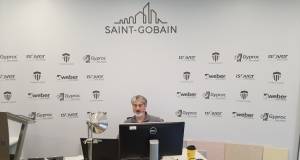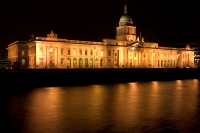- Conservation
- Posted
Inquiry urged into Skellig rock conservation
An
independent archaeologist has called for an inquiry into conservation
works carried out at Skellig Michael by the Office of Public Works,
following its admission that it has been dumping rock and spoil at the
location.
An
independent archaeologist has called for an inquiry into conservation
works carried out at Skellig Michael by the Office of Public Works,
following its admission that it has been dumping rock and spoil at the
location.
Michael Gibbons, a Connemara-based archaeologist, said the dumping constituted "fly-tipping", which was "partially destroying" the only unreconstructed part of the Unesco World Heritage site.
The OPW denied it had caused any damage while disposing of soil, which was to have been flown off the South Peak by helicopter. Instead, some five bags of soil and "small stones" were disposed of in a ravine below the island's oratory terrace, it said.
Mr Gibbons, who has been a critic of OPW work on the site, has reported the instance to Unesco and to the Minister for the Environment, John Gormley. Such dumping in an area that is also a bird and marine sanctuary "flies against best international practice", and is in breach of article 6 of the EU habitats directive, Mr Gibbons told The Irish Times.
"This highlights the cavalier attitude of the management team on Skellig Michael. We already know that there is no environmental archaeological input into the management team, and much of the work is being done without direct archaeological supervision - but with work being inspected later.
"The OPW is trying to give the impression that these are small bags of stones it dumped. In fact, each bag weighs well over a tonne, which is why it was to have been lifted away by helicopter."
Last year Mr Gibbons questioned the absence of any management plan for the restoration being carried out on the OPW's behalf on the rock. He also criticised the fact that accidental damage had been caused to the island's South Peak oratory, or hermitage, during this work.
The oratory was built by the island's monks sometime between the sixth and eighth centuries when they laid out three terraces on the edge of rock some 218m above sea level. An "over-restoration" by the OPW had resulted in a "reconstruction" of sections of the oratory rather than conservation of the original, Mr Gibbons claimed, and caused serious damage to an original altar.
Mr Gibbons said independent evaluation of work, as required under Unesco guidelines, was critical to preventing over-restoration of sites. No restoration should be done on the Skelligs beyond the "absolute minimum necessary", he said. OPW archaeological and architectural staff described Mr Gibbons's comments as "ill-informed and unjustified".
However, former minister for the environment Dick Roche commissioned a draft management plan, and his successor, Mr Gormley, has recently announced an extension to the public consultation stage of this to September 28th. The draft plan will set out the measures required to ensure protection, conservation and management of the world heritage site for the next 10 years.
Responding to Mr Gibbons's latest concerns, the OPW said there were no nesting birds in the ravine where the spoil was dumped. A project archaeologist had carried out a visual inspection of the area from Christ's Saddle, and had reported no "scars" visible".
It said it had invited Mr Gibbons to meet on site with the project team.
Lorna Siggins
© 2007 The Irish Times
Michael Gibbons, a Connemara-based archaeologist, said the dumping constituted "fly-tipping", which was "partially destroying" the only unreconstructed part of the Unesco World Heritage site.
The OPW denied it had caused any damage while disposing of soil, which was to have been flown off the South Peak by helicopter. Instead, some five bags of soil and "small stones" were disposed of in a ravine below the island's oratory terrace, it said.
Mr Gibbons, who has been a critic of OPW work on the site, has reported the instance to Unesco and to the Minister for the Environment, John Gormley. Such dumping in an area that is also a bird and marine sanctuary "flies against best international practice", and is in breach of article 6 of the EU habitats directive, Mr Gibbons told The Irish Times.
"This highlights the cavalier attitude of the management team on Skellig Michael. We already know that there is no environmental archaeological input into the management team, and much of the work is being done without direct archaeological supervision - but with work being inspected later.
"The OPW is trying to give the impression that these are small bags of stones it dumped. In fact, each bag weighs well over a tonne, which is why it was to have been lifted away by helicopter."
Last year Mr Gibbons questioned the absence of any management plan for the restoration being carried out on the OPW's behalf on the rock. He also criticised the fact that accidental damage had been caused to the island's South Peak oratory, or hermitage, during this work.
The oratory was built by the island's monks sometime between the sixth and eighth centuries when they laid out three terraces on the edge of rock some 218m above sea level. An "over-restoration" by the OPW had resulted in a "reconstruction" of sections of the oratory rather than conservation of the original, Mr Gibbons claimed, and caused serious damage to an original altar.
Mr Gibbons said independent evaluation of work, as required under Unesco guidelines, was critical to preventing over-restoration of sites. No restoration should be done on the Skelligs beyond the "absolute minimum necessary", he said. OPW archaeological and architectural staff described Mr Gibbons's comments as "ill-informed and unjustified".
However, former minister for the environment Dick Roche commissioned a draft management plan, and his successor, Mr Gormley, has recently announced an extension to the public consultation stage of this to September 28th. The draft plan will set out the measures required to ensure protection, conservation and management of the world heritage site for the next 10 years.
Responding to Mr Gibbons's latest concerns, the OPW said there were no nesting birds in the ravine where the spoil was dumped. A project archaeologist had carried out a visual inspection of the area from Christ's Saddle, and had reported no "scars" visible".
It said it had invited Mr Gibbons to meet on site with the project team.
Lorna Siggins
© 2007 The Irish Times
Last modified on Wednesday, 22 August 2007 23:12
Related items
-
 Saint Gobain launches online technical academy
Saint Gobain launches online technical academy -
 Bord Gáis calls it quits on home insulation business
Bord Gáis calls it quits on home insulation business -
 Two thirds of new Irish homes fail energy efficiency rules
Two thirds of new Irish homes fail energy efficiency rules -
 Brian Motherway named new chief executive of SEAI
Brian Motherway named new chief executive of SEAI -
 Government launches public consultation on building control
Government launches public consultation on building control -
 Fuel poverty finally taken seriously - Energy Action
Fuel poverty finally taken seriously - Energy Action

